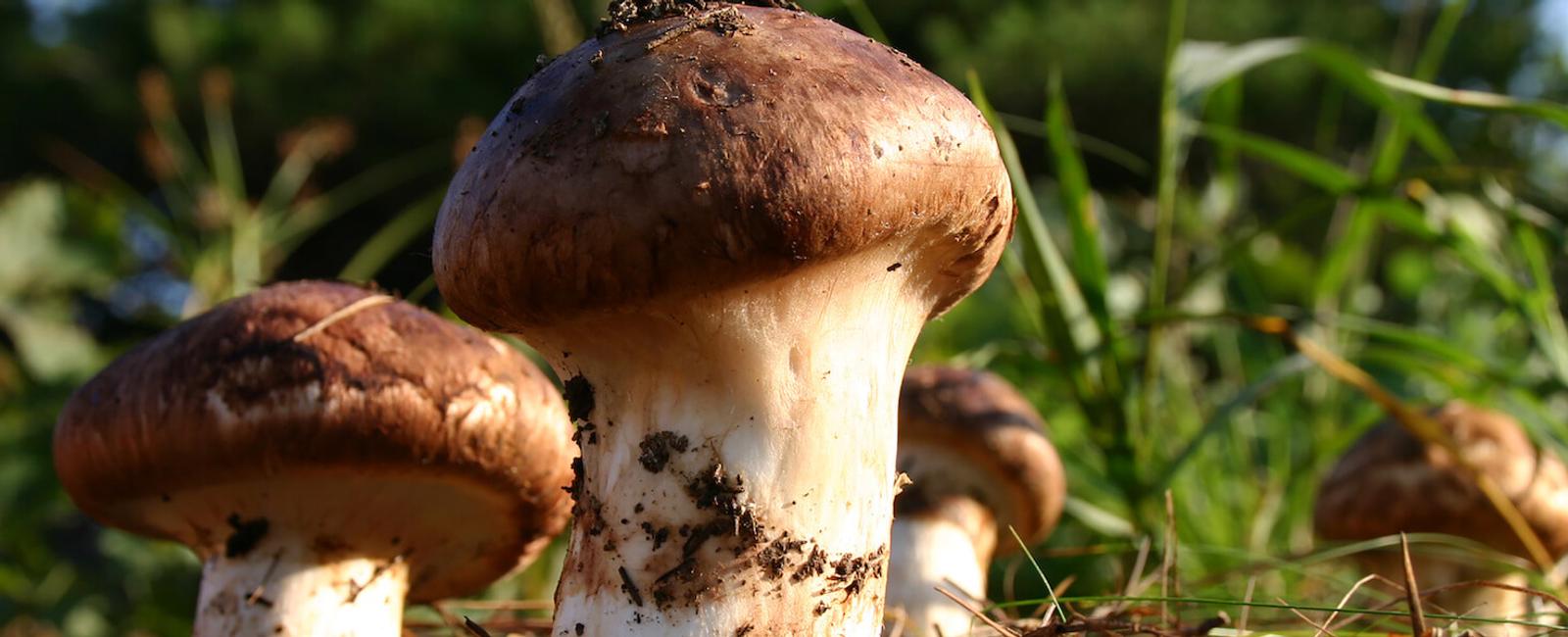

Mushrooms are a fascinating and diverse group of organisms, with thousands of species found worldwide. One particular mushroom species that has gained popularity and recognition is the matsutake mushroom. With a unique taste and rich history to match, it’s no wonder these little brown mushrooms are highly prized.
In this guide, we’ll explore the fascinating world of matsutake mushrooms. We’ll talk about what they are, where they grow, how to enjoy them, and much more. Let’s jump in!
What are matsutake mushrooms?
Matsutake mushrooms (Tricholoma matsutake) are an edible mushroom highly valued in Japanese and Asian cultures. In Japanese, matsutake means “pine mushroom,” although you may also see it referred to as the tanoak mushroom. Both names allude to where you can find these mushrooms in the wild.
Wild matsutake mushrooms are rare and can fetch extraordinary prices, ranging from $1,000 to $2,000 per pound, depending on their quality. Varieties grown in the United States are considerably cheaper, around $40 per pound (1).
The varieties of matsutake mushrooms that grow outside of Japan are different. Tricholoma magnivelare is the American matsutake found east of the Rocky Mountains. Tricholoma murrillianum is located west of the Rockies. Experienced foragers note the western variety is whiter in color than the eastern. However, the best way to tell the difference is where you harvest them (2).
Matsutake mushrooms have a symbiotic relationship with the pine trees they grow under as the tree roots mix and mingle with the matsutake’s mycelium (more on that soon). Both species can exchange nutrients and water (3).
Psst: There are other regional varieties of matsutake mushrooms. Tricholoma neausoesum is the Swedish matsutake, and another recently identified in Mexico is Tricholoma mesoamericanum (4)!
What do matsutake mushrooms look like?
Pine mushrooms are usually large, white mushrooms with reddish brown (or sometimes orangey brown) patches and coloring. Another distinguishing feature is their scent, described as spicy, piney, and even reminiscent of cinnamon. They have a white spore print.
Two of the most important features that set matsutake mushrooms apart from lookalikes are their scent and hardiness. These mushrooms are dense with a rubbery texture and a stem that can’t be crushed between your fingers (2).
Where do matsutake mushrooms grow?
Pine mushrooms grow throughout Asia (in Japan, China, and Korea), in parts of Europe (Sweden and Finland), as well as throughout North America (Canada, Oregon, California, Washington, and Colorado).
These mushrooms grow in pine forests, which means you’ll find them near pine trees such as Douglas fir, Ponderosa pine, and Lodgepole pine. The soil around the pine trees is sometimes thin and sandy. They’ll even grow underneath moss (2).
Psst: Matsutake mushrooms used to be abundant in Japan, but diseases and changes in environmental management have made them scarce. Now, up to 90% of matsutake mushrooms harvested in Oregon are exported to Japan, leading some to refer to matsutake mushrooms as “white gold” (5).
Historical and traditional use of matsutake mushrooms

Mushrooms are often considered sacred in traditional medicine schools, and matsutake mushrooms have enjoyed being held in high esteem—although in slightly different ways than your average medicinal mushrooms.
Matsutake mushrooms have a rich history in Japanese culture spanning centuries; these humble mushrooms appeared in poems written more than 1,300 years ago. The sport of gathering these mushrooms was treasured as well.
Each autumn, nobles would harvest matsutake mushrooms during the Heian era (794 AD–1185). Even the Samurai were known to have enjoyed hunting for matsutake mushrooms in the late 16th century. Matsutake mushrooms remained in the realm of the upper classes until the mid to late 1800s, before they were more widely available to others (5).
The tradition of gifting matsutake mushrooms during autumn is an integral part of Japanese culture (6).
Psst: Another reason the matsutake mushroom has been revered in Japanese culture? It’s said to represent longevity, hence its popularity in gift-giving.
Health benefits of matsutake mushrooms
Like other culinary mushrooms, matsutake mushrooms are loaded with nutrients. Matsutake mushrooms are high in protein and fiber, making them perfect for nourishing gut health and repairing and building your body’s tissues.
They’re also high in vitamins and minerals, especially methionine, an essential amino acid. Matsutakes are abundant in glutamic acid, which supports metabolism, your nervous system, brain function, and liver health.
A bevy of vitamins and minerals such as potassium, zinc, copper, selenium, and B vitamins round out matsutake’s nutritional profile (6).
Ethically wildcrafting matsutake mushrooms

Ready to lace up your hiking boots and search for matsutake mushrooms? If so, there are some essential things to learn before jumping into mushroom hunting. While foraging and ethical wildcrafting may seem similar, they can differ tremendously in their respective approaches.
Foraging is a more general term and refers to gathering wild food sources. Wildcrafting is more specific and refers to harvesting local resources for medicinal needs. Ethical wildcrafting also has a much more holistic approach to harvesting, considering short- and long-term effects on the local environment.
Learning the local area
Ethical wildcrafting is much more than simply gathering mushrooms; it means learning as much as you can about the local environment so you can mindfully harvest mushrooms with the lowest impact
Take the time to learn about other mushroom species in the area. You’ll know which may be threatened or endangered and potentially any dangerous lookalikes you’ll want to avoid. While some mushrooms are quickly identified, not all are, and it’s critical to know the difference. Consult a field guide or a professional if you need more clarification on whether what you’re harvesting is safe.
Look into any special permits you may need to wildcraft mushrooms as you may need them for some national forests.
Psst: At first glance, Amanita smithiana (a highly poisonous mushroom) could be confused for matsutake mushrooms. Start by comparing the stems of each mushroom. Remember, matsutake’s stems are firm. An Amanita stem will shatter under pressure, but matsutake won’t unless it’s riddled with insect activity and is no longer edible. Unlike Amanita smithiana, matsutake mushroom flesh will peel like string cheese, and the stem is wider near the gills (7).
Mushroom anatomy and proper harvesting
A big part of properly harvesting your mushrooms involves understanding mushroom anatomy. Even though it might seem like whatever we see above ground is the whole mushroom, it’s only the fruiting body.
Just beneath the surface lies another essential part of the mushroom: the mycelium. Sometimes called the “wood wide web,” this unique network allows mushrooms, plants, and trees to communicate. Made up of delicate fibers called hyphae, these bundles of filaments form the mycelium. And while it helps with nutrient uptake and absorption, it also communicates information about changing environmental conditions, including nearby predators.
Careless harvesting can damage this sophisticated network, so use the right tools for gathering your mushrooms and learn which method of harvesting will cause the least damage.
Psst: You can find matsutake mushrooms by looking for tiny little bumps in the soil and debris on the forest floor (also called duff). But don’t use a rake to clear it or you could damage the mycelium. Slide a knife under the base to pry the mushroom up and out of the ground. Being mindful can mean the difference between new mushrooms growing in a matter of days or not at all. Gently fill the void with dirt and pat it down as this protects the mycelium (8).
Ecosystem preservation
Another element of ethical wildcrafting involves only harvesting what you need. Deer, squirrels, rodents, insects, birds, and other creatures enjoy feasting on mushrooms. Being mindful of how (and how much) you’re harvesting ensures everyone can continue enjoying it together.
Psst: While we recommend making a spore print of your mushroom so you can begin growing a favorite variety at home, matsutake or pine mushrooms are notoriously difficult to cultivate; some say impossible. For now, be mindful of how much you’re harvesting.
How can you enjoy matsutake mushrooms?

Matsutake mushrooms have a unique flavor profile. Some describe them as having a spicy flavor reminiscent of their growing environment—the pine trees impart a subtle flavor that can’t be missed. Here are some of our favorite matsutake mushroom recipes to serve as inspiration in the kitchen.
Matsutake gohan
Matsutake gohan may be the most popular way to enjoy matsutake mushrooms in Japan. This one-pot rice dish is perfect for the weekend or when you have a little extra time during the week. Seasoned with mirin, soy sauce, and sake, this delightful meal is brimming with umami flavor thanks to the addition of dashi broth. Dashi is a Japanese soup stock and is a cornerstone of Japanese cooking. If you’re already a fan of clear broths, add dashi to your list!
While this recipe calls for fresh matsutake mushrooms, if you find dried matsutake mushrooms, give those a try. Like shiitake mushrooms, dried matsutakes are more flavorful, so adjust the amount you use accordingly.
Sukiyaki
Looking for another super-simple matsutake mushroom recipe? Try making Sukiyaki. Another Japanese one-pot dish, it’s commonly cooked and eaten at the table. Even more, this recipe lends itself well to what you have on hand, whether beef, poultry, pork, or seafood. Stick with enoki mushrooms as the recipe calls for, freshly gathered matsutake mushrooms, or a mix of whichever wild mushrooms you can find locally.
Congee
Cozy comfort in a bowl, congee is equally delightful as a hearty and filling breakfast, an easy lunch, or a soul-satisfying dinner. Thanks to the Instant Pot, this breakfast congee requires little supervision, and the cooking time is cut in half.
Savory chicken broth seasoned with ginger and green onion, crispy bacon, and fried eggs garnished with chili or sesame oil keeps you deliciously full for hours. It’s also ideally suited to adding some garlicky sauteed matsutake mushrooms. All it takes are a few quick ingredient swaps to make your leftovers midday meal ready. Consider grilling up some chicken for the week, adding fried shallots, toasted peanuts, and freshly chopped cilantro for a reimagined dish in no time.
Matsutake mushrooms: A rare and prized mushroom
Rare and somewhat elusive, the matsutake mushroom has been treasured throughout the centuries in Japanese and Asian culture. With their delightfully different and unique flavor, it’s no wonder matsutake mushrooms are as beloved as they are.
Still craving mushrooms? For more mushroom happenings, including news and breakthroughs on medicinal and psychedelic mushrooms, be sure to keep up with us on shroomer.
References
- Nami. “Matsutake Gohan (Wild Pine Mushroom Rice) 松茸ご飯.” Just One Cookbook, December 14, 2022. https://www.justonecookbook.com/matsutake-gohan/
- “Vancouver Island Mushrooms - Matsutake Pine Guide,” n.d. https://www.westcoastforager.com/wild-edible-mushrooms/matsutake-pine-guide
- Stoch, Tristan. “Matsutake (Mushroom).” Portland State University and the Oregon Historical Society, May 18, 2023. Accessed August 12, 2023. https://www.oregonencyclopedia.org/articles/matsutake-mushrooms/
- Bergo, Alan. “Matsutake or Pine Mushrooms: Identification, Harvesting and Cooking.” Forager | Chef, August 5, 2023. https://foragerchef.com/there-can-be-only-one-matsutakepine-mushroom-2/
- Nishino, Katsutoshi. “Chemical Ecology of the (Oxalato)Aluminate Complex as an Antimicrobial Substance from the ‘Shiro’ of Tricholoma Matsutake (Dissertation_全文).” Kyoto University, July 24, 2017. Accessed August 14, 2023. https://repository.kulib.kyoto-u.ac.jp/dspace/bitstream/2433/226789/3/dnogk02242.pdf
- Redden, Claire. “The Rare Japanese Mushroom That Packs A Bold Flavor.” Tasting Table, February 22, 2023. https://www.tastingtable.com/1207368/the-rare-japanese-mushroom-that-packs-a-bold-flavor/
- Beug, Michael W. “How to Distinguish Amanita Smithiana from Matsutake and Catathelasma Species.” How to Distinguish Amanita Smithiana From Matsutake and Catathelasma Species, January 2017. Accessed August 13, 2023. https://namyco.org/docs/MycophileJanFeb2017.pdf
- Forest Service. “Matsutake Mushrooms.” Accessed August 14, 2023. https://www.fs.usda.gov/detail/fremont-winema/passes-permits/forestproducts/?cid=fsbdev3_061820


